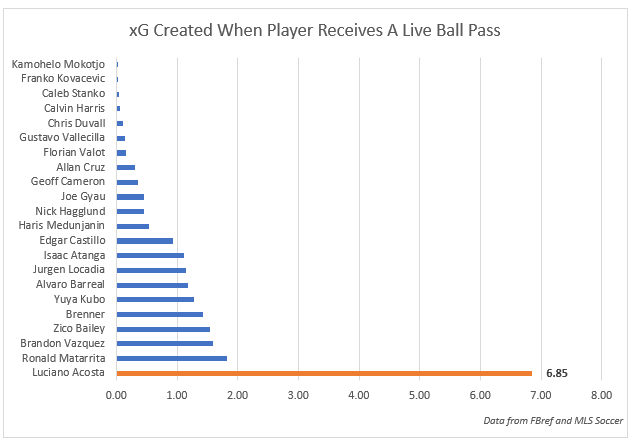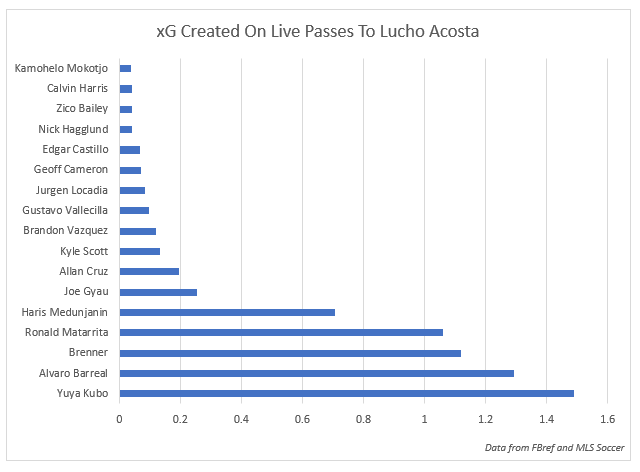When FC Cincinnati dropped it’s “Mic’d Up” with new head coach Pat Noonan, it provided a great look into how the team was progressing during its first preseason trip to Florida. If you haven’t watched the video, you should. It’ll scratch an itch to see the Orange and Blue on the field and at the very least, provided a look behind the curtain into how Noonan operates.
Drawing conclusions from a video cut from who knows how much footage to just over four minutes in length isn’t exactly advisable. But hey, it’s preseason and the roster incomings haven’t materialized.
While watching the video, there was one thing in particular that stuck out to me.
At about the 3:10 mark, there’s some B-roll of Lucho Acosta on the ball in a drill working on transitioning from defense to attack, back to defense. During a stoppage, Noonan says, “…too many times we’re passing up a pass that puts Lucho on the ball facing goal.” He continues, “Think about the strengths of your teammates.”
Given what we believe to be a tactical shift to a more aggressive pressing system, maximizing Acosta’s opportunities to create in transition should be a major factor in the Orange and Blue’s attacking plan in 2022.
For the 2021 season, I combined shot data from Football Reference with expected goal data from MLS Soccer. Basically, it’s a spreadsheet with every shot FCC took during the season with corresponding xG values. Looking at shot creating actions shows how FCC created chances in 2021 and exactly what Noonan was talking about.
First, for anyone unfamiliar, Football Reference tracks two shot creating actions for each shot during matches. Shot creating actions can be passes, tackles, interceptions, dribbles, fouls drawn – basically any event that can lead directly to a shot. So if Yuya Kubo finds Lucho Acosta with a pass in the final third and Acosta turns and slips Brenner through on goal and he gets a shot off, Kubo would be credited with a shot creating action (listed as shot creating action 2) and Acosta would be as well (listed as shot creating action 1).
For those of you familiar with the concept of a secondary assist in hockey, that’s essentially all something recorded as the second shot creating action is, except it can be any action not just a pass.
Back to it. The basic numbers on Fbref tell us that Acosta’s passes led to 7.5 xG (his 7.5 expected assists), far and away the highest on the team. We can also see that Acosta led the team in shot creating actions with 163, 102 more than Brenner’s 61. However, combining shot creating action data with xG allows us to see Acosta’s contributions more clearly.
Specifically looking for situations where Acosta received a non-dead ball pass and then did something leading to a shot, FCC created 6.85 xG. In similar situations, the entire rest of the team combined to create just 14.74 xG.

We can dig deeper, too. Acosta’s primary shot creating actions from live play passes came in the form of passes to set up teammates’ shots, 4.81 xG. Acosta also created for himself, producing dribbles to set himself up for shots worth 1.98 xG. No FCC player set up their teammates for scoring opportunities better than Luciano Acosta when he received the ball in the run of play.
This is what Noonan is talking about, maximizing opportunities to get FCC’s most creative player on the ball in situations where he can manufacture a shot for himself or find a teammate in position to take a shot.
Who passed to Acosta, setting him up to find the action before the shot, is interesting as well. Yuya Kubo, Alvaro Barreal, Brenner, and Ronald Matarrita all found Acosta with open play passes in to create more than one xG over the course of the season.

The link between Kubo and Acosta will continue to be vital for the Orange and Blue this season because of Kubo’s presumptive role as a main ball shuttler from midfield.
The Philadelphia Union’s attacking system, which we should expect 2022 to share some tactical DNA with, heavily relied on fullbacks for ball progression, something Matarrita showed he can do. Getting a little bit more forward passing into attacking situations the other fullback spot, whether it be new additions Ray Gaddis or Alvas Powell will be important to a more sustainable attack.
There’s one last thing that should be noted in all of this. Despite being FCC’s primary creative force when receiving the ball in open play, shots resulting from passages of play where Acosta provided the pass before the shot creating action also had the highest expected goals value throughout the season.
Too often in 2021, as FCC struggled for reliable options progressing the ball from midfield, Acosta was forced deeper and deeper to pick up the ball, leaving him as the main option to enter the ball into the final third despite being the player you’d most like to be receiving the ball in those positions.

Finding different build up patterns of play to get the ball to Acosta in dangerous situations should be, and sounds like it is already, a point of emphasis for Noonan and his staff in preseason. Acosta demonstrated a willingness, and to be fair, an ability, to be a one man offensive engine. But hopefully he won’t have to do both again, at least not all the time.
Putting in place a tactical structure to maximize Acosta’s ability to do what he does best while limiting the need for him to drop deep to help get the ball into dangerous areas should benefit the Orange and Blue going forward. A system built around winning the ball back high up the field and finding Acosta in transition and in space where he can assess and find teammates in positions to take shots would get the best out of his skillset.
Let’s hope more structure, regardless of formation, can put Acosta in more situations to thrive in 2022.












